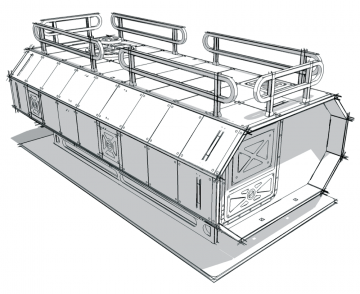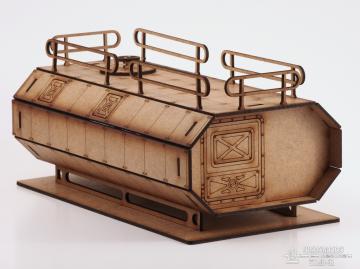Company: Sarissa PrecisionRetail Price:
£16
Coming to market toward the end of 2011 was Sarissa Precision's 'System ∞' set of modular laser-cut MDF scenery. As the Settler Pod is largely identical to the previously reviewed Explorer Pod this review will mostly look at changes from the smaller pod. The Settler Pod is in the middle of the sizes of buildings available from Sarissa. Looks & Styling As with the Explorer, this is unashamedly industrial in style with big flat panels, rivets, huge over-size doors and very little in the way of architectural 'frills'. This is a prefab structure and doesn't pretend to be anything else. The basic structure is an elongated octagon in cross-section which helps remove some of the blockiness inherent in laser-cut sheet construction, with each piece being divided into panels via surface etching. There are a number of smaller panels marked onto the model with the two on the side panels being removeable while the one on the roof is just there for decoration. Likewise the inner panel in the top half of each door is removable.
Parts, Fit and Construction Construction is identical to the Explorer but the review copy wasn't as excellently cut as the review Explorer - some of the slots in the long strips were very tight, enough that you would need to file out the slots slightly or risk using excessive force to get the tabs into them. The slots in the floor on the other hand were slightly loose and would need gluing to stop the walls lifting off the floor when picking up the model. The kit has two inner 'rim' bulkheads that aren't present in the Explorer. These are only held in place by two 2 mm tabs on the bottom so will need gluing in, but in a glued model will add a lot of structural integrity to the long side panels and will also help support the roof: As with the Explorer, construction from opening the packet to the finished item is a few minutes, slightly more if you want to glue the joints.
Scale and Dimensions The kit is again scaled for use with 28 mm models. As with the Explorer the doorway and circular top hatch make the model look over-scaled but with the increased size of the pod it's not quite as bad. Here are the scale photos of the Explorer again: The external dimensions of the Pod are 106x214 mm (the base sheet is identical in size) by 74 mm high. The handrails add another 21 mm taking it up 95 mm in total. The doorways are a fraction over 40 mm wide by 45 mm high meaning that you can fit a 40k Terminator or Infinity Remote through them. Assembled unpainted weight is around 240 g.
Game Use and Robustness In-game the Pod does a good job of blocking line of sight and giving models some corners to cower behind/take cover behind while shooting. The large doors can look a bit odd but do make it easy to fit a model into the doorway without lifting the roof off. On the subject of the roof, having it lift off without any force is extremely useful, while the handrails will stop any models on the roof sliding off to their doom. The hatch on the roof has a hole large enough to fit a 25 mm base through so if you're feeling vindictive towards your models you could drop them through instead of lifting the roof off. Robustness is a mixed bag. The unit itself is very solid but the extras like the handrails and to a lesser extent the supporting struts 'feel' week due to the 2 mm material and their small cross-sections. Although I haven't tested the handrails to destruction to be sure, they'd be unlikely to survive the way club scenery tends to get piled up in boxes.
Summary As with the Explorer this is cheap affordable terrain and in terms of table coverage you're getting double the footprint of the Explorer for a 33% increase in price which is a pretty good deal.
Integration with the rest of the Sarissa range is better with the Settler as the roof has additional holes on the side suitable for adding access ladders etc: Below you can see the Explorer stacked on top of the Settler as the spacing of the roof holes is designed to fit any combination of octagonal pods on top of each other: Note that you can't use the long hand rails in this setup as there isn't enough room left by the upper pod, but you'd want to add an access ladder or walkway anyway.
Pros
Cons
|
|||
 |
||||||||
|
|
|



















